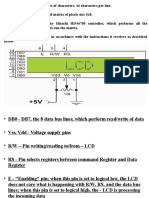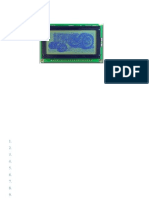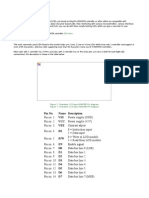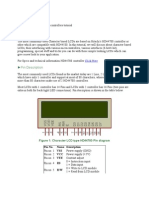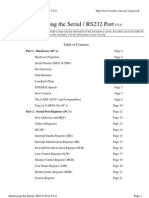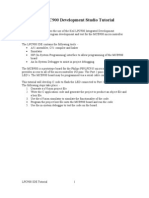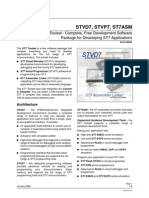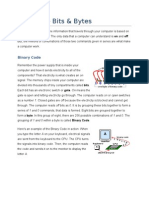LCD Program With Uvision
Uploaded by
api-3697475LCD Program With Uvision
Uploaded by
api-3697475Application Note
Interface and Simulation of a LCD Text Display APNT_161
OVERVIEW
The following application note describes the interface of a LCD text display to a 8051
microcontroller system. This application note comes with the µVision2 project
LCD_Display.UV2 that includes C source code of the interface software and a complete
simulation script for simulator based testing. In this example, we are using the LCD-Controller
ST6077. However, the interface to other text displays is similar.
µVision2 provides full integration of the C51 compiler and debugger. Today applications need
to be tested before real hardware becomes available. Therefore µVision2 offers both: a simulator
that seamless simulates the complete peripherals of countless 8051 derivatives, and a target
debugger that allows software testing in real hardware with a target monitor or emulator.
If you open the µVision2 project LCD_Display.UV2 you can easily follow the steps described in
this application note.
HARDWARE INTERFACE
This section gives an overview about the connection and communication between the ST6077
LCD display device and the 8051 microcontroller. Details are provided in the datasheet
st6077v151.pdf that comes in the file APNT_161.ZIP.
The schematic below shows you how the devices are connected:
The data bus of the ST7066 is connected to the 8051 Port P0. The three control pins RS, RW,
and E are connected to the 8051 I/O Port P2.0 – P2.1. These connections are reflected in the
software interface.
Overview of the display pins
DB0 – DB7 8bit data bus
RW Selects Read or Write mode
0: Read
1: Write
RS Select Registers
0: Instruction register (for write) / address counter (for read)
Page 1 of 6 Revision date: 26-Jun-01
Application Note
Interface and Simulation of a LCD Text Display APNT_161
1: Data Register (read and write)
E Enables data read/write (This has to follow each command)
SOFTWARE INTERFACE
The file LCD_interface.C, that comes with the µVision2 project LCD_Display.UV2 is the
source code that handles all basic input/output to the LCD text display. You may use this file as
template for your own 8051 display driver.
/*------------------------------------------------------------------------------
LCD_interface.C
Copyright 2001 Keil Software, Inc.
------------------------------------------------------------------------------*/
#include <reg51.h>
#include <stdio.h>
#include <intrins.h>
sbit P20_PIN = P2^0; // I/O Pin for P2.0
sbit P21_PIN = P2^1; // I/O Pin for P2.1
sbit P22_PIN = P2^2; // I/O Pin for P2.2
#define LINE1_ADDR 0x00 // Start of line 1 in the DD-Ram
#define LINE2_ADDR 0x40 // Start of line 2 in the DD-Ram
/* Display-Commands */
#define CLEAR_DISPLAY 0x01 // Clear entire display and set Display Data Address to 0
#define DD_RAM_PTR 0x80 // Address Display Data RAM pointer
#define DISP_INIT 0x38 // 8 bit 2 lines
#define INC_MODE 0x06 // Display Data RAM pointer incremented after write
/*
* ReadInstrReg: Read from Instruction Register of LCD Display Device
*/
static unsigned char ReadInstrReg (void) {
unsigned char Instr;
P0 = 0xff; // DATA PORT is input
P20_PIN = 0; // select instruction register
P21_PIN = 1; // read operation
P22_PIN = 1; // give operation start signal
_nop_ (); _nop_ (); // wait
Instr = P0; // read Instruction
P22_PIN = 0;
return(Instr);
}
/*
* WriteInstrReg: Write to Instruction Register of LCD Display Device
*/
static void WriteInstrReg (unsigned char Instr) {
P20_PIN = 0; // select instruction register
P21_PIN = 0; // write operation
P22_PIN = 1; // give operation start signal
_nop_ (); _nop_ (); // wait
P0 = Instr; // write instruction
P22_PIN = 0;
P0 = 0xff; // DATA_PORT is input [prevent I/O-Port from damage]
}
/*
* ReadDataReg: Read from Data Register of LCD Display Device
Page 2 of 6 Revision date: 26-Jun-01
Application Note
Interface and Simulation of a LCD Text Display APNT_161
*/
static unsigned char ReadDataReg (void) {
unsigned char val;
P0 = 0xff; // DATA_PORT is input
P20_PIN = 1; // select data register
P21_PIN = 1; // read-operation
P22_PIN = 1; // give operation start signal
_nop_ (); _nop_ (); // wait
val = P0; // read Instruction
P22_PIN = 0;
return (val);
}
/*
* WriteDataReg: Write to Data Register of LCD Display Device
*/
static void WriteDataReg (unsigned char val) {
P20_PIN = 1; // select data register
P21_PIN = 0; // write operation
P22_PIN = 1; // give operation start signal
_nop_ (); _nop_ (); // wait
P0 = val; // write value
P22_PIN = 0;
P0 = 0xff; // DATA_PORT is input [prevent I/O-Port from demage]
}
char putchar (char c) {
unsigned char line;
if (c == '\n') {
line = ReadInstrReg ();
if (line & LINE2_ADDR) { // is already in line 2
WriteInstrReg (LINE1_ADDR | DD_RAM_PTR); // place to start of line 1
}
else {
WriteInstrReg (LINE2_ADDR | DD_RAM_PTR); // place to start of line 2
}
}
else {
WriteDataReg (c);
}
return (c);
}
/*
* Waits for some time so the 7066 can do the last command
*/
void wait (unsigned int time) {
int i;
for (i = 0; i < time ;i++){
}
}
}
/*
* Clear_Display: Write 0x20 to Display RAM
*/
static void Clear_Display (void) {
WriteInstrReg (CLEAR_DISPLAY);
wait (1);
}
The putchar function is the basic output routine that is used for simple character output. These
function is used by the function printf. In addition we have implemented the function
Clear_Display.
Page 3 of 6 Revision date: 26-Jun-01
Application Note
Interface and Simulation of a LCD Text Display APNT_161
The following test code allows you to check the implementation.
void main (void) {
unsigned char c;
for (c = 'A'; c < 'H'; c++) { // Put the characters A to H to the display
putchar (c);
}
printf ("Hello \n"); // Puts ‘Hello’ to the display using printf()
Clear_Display (); //Clear the display and reset cursor
for (c = 0; c < 10; c++) {
printf ("This is Display Line %bd\n", c); // another printf() testing
}
while (1); //never stop
.
Function Overview of the Software Interface
ReadInstrReg () Returns the instruction in the instruction register.
WriteInstrReg (Instr) Writes the instruction Instr out to the instruction register. Nothing is
returned.
ReadDataReg () Returns the value in the Data Register.
WriteDataReg (val) Writes the value val to the Data Register.
putchar (c) Behaves like a normal putchar value. The value in c is written to the
display and returned if it was successful.
Clear_Display () Clears the entire Display by filling the Data Ram with blanks.
The test code does not use all interface functions, but they are implemented for completeness.
µVISION2 SIMULATION
The following section shows you how to simulate the LCD text display with µVision2.
The µVision2 simulator provides several ways to simulate a text display. One of the easiest
methods is to use the µVision2 memory window as ASCII display. In addition to the standard
microcontroller memory, µVision2 offers four user defined memory spaces that are accessed
with the prefixes S:, T:, U:, and V:. We are using the U: memory space as display memory for
the LCD text display. The µVision2 memory window is used in ASCII mode. You may resize
the window, so that it reflects the size of your LCD display as shown below.
The following µVision2 script defines debug functions and other required settings to simulate the
LCD text display.
Page 4 of 6 Revision date: 26-Jun-01
Application Note
Interface and Simulation of a LCD Text Display APNT_161
The MAP command reserves 80 Bytes of the user-memory U:. The size is identical to your
display size. In this example:
2 rows * 0x40 characters = 0x80 character with 1 Byte each
The debug function Simulate_Display is triggered on a write to Port 2 (P2). This behavior is
defined with the BreakSet command on the last line of the µVision2 script. This command
connects the control lines of the LCD text display controller to the simulated 8051 device.
Any write event on Port 2 (P2) calls the function Simulate_Display. Depending on the
previous Port 2 (SD_oldPORT2) state, a LCD display read or write command is performed as
explained in the following diagram.
Read from display Write to display
• Read from LCD display: E (P2.2) signal changes from low to high.
• Write to LCD display: E (P2.2) signal changes from high to low.
The signal RS (Port 2.0) selects the instruction register or the display RAM of the LCD
device. The signal RW (Port 2.1) defines a read or write command to the LCD device.
define unsigned char SD_oldPORT2;
define unsigned char SD_cursor;
MAP U:0, U:0x80 READ WRITE // This line maps the user memory.
// U:0 as start address in the memory window shows it
/*
* Simulate the 'Clear Display' command
*/
func void SD_clear (void) {
unsigned char i;
for (i = 0; i < 0x80; i++) {
_WBYTE (U:0+i, 0x20);
// Writes blanks to the whole user memory ( display memory )
}
SD_cursor = 0; // Sets the cursor to the origin
}
/*
* Process all commands of the LCD display controller
*/
func void Simulate_Display (void) {
if (!(SD_oldPORT2 & 0x04) && (PORT2 & 0x04)) { // LCD read: E changes to high
if ((PORT2 & 0x03) == 0x02) { // read flag register
PORT0 = (SD_cursor & 0x7F); //return DD RAM pointer to port 0 of the 8051
}
Page 5 of 6 Revision date: 26-Jun-01
Application Note
Interface and Simulation of a LCD Text Display APNT_161
if ((SD_oldPORT2 & 0x04) && !(PORT2 & 0x04)) { // LCD write: E changes to low
if ((PORT2 & 0x03) == 0) { // write to command register
if (PORT0 == 0x01) { // command is 'Clear Display'
SD_clear (); // call the 'Clear Display' simulation
}
if (PORT0 & 0x80) { // Set DDRAM address (cursor position)
SD_cursor = (PORT0 & 0x7F); // set DD RAM pointer
}
}
if ((PORT2 & 0x03) == 0x01) { // command is 'Write to RAM'
_WBYTE (U:0+SD_cursor, PORT0); // write to DD RAM (user memory @ U:0xXX)
SD_cursor++; // Advance cursor position by 1
}
if (PORT2 & 0x02) { // read mode
PORT0 = 0xFF; // display data goes to high
}
}
SD_oldPORT2 = PORT2; // store E for change detection
}
BS WRITE PORT2, 1, "Simulate_Display ()"
The debug function Simulate_Display analyses some of the states of the LCD display device.
To simplify the debug function, we have only implemented the commands that are used by the
C51 software interface. The variable SD_cursor holds the cursor position in the DDRAM
(diplay memory) and is used as pointer to the user memory U:.
CONCLUSION
Implementing an LCD text interface is straight forward with the Keil development tools. It is
even possible to simulate the whole target system with µVision2 without scarifying execution
speed. The simulation model described in this application note may be adapted to most other
LCD text display controllers.
This application note uses the µVision2 debug functions as peripheral interface. Application
Note 154 “Implementing µVision2 DLL´s for Simulating User Defined
Hardware” describes an interface that is able to simulate complex peripherals which require
accurate timing and/or several input/output variables.
Page 6 of 6 Revision date: 26-Jun-01
You might also like
- Interfacing LCD With PIC Microcontroller - MPLAB XC8No ratings yetInterfacing LCD With PIC Microcontroller - MPLAB XC88 pages
- EKT222 Microprocessor System Northern Malaysia University College of EngineeringNo ratings yetEKT222 Microprocessor System Northern Malaysia University College of Engineering4 pages
- Interfacing A Hantronix 320 X 240 Graphics Module To An 8-Bit MicrocontrollerNo ratings yetInterfacing A Hantronix 320 X 240 Graphics Module To An 8-Bit Microcontroller8 pages
- TM1115 - STM32F103ZE - Chapter 6 (I2C - LCD)No ratings yetTM1115 - STM32F103ZE - Chapter 6 (I2C - LCD)23 pages
- Lecture-22-ESD-LCD-Fall-2024-Anzar-11122024-122349pmNo ratings yetLecture-22-ESD-LCD-Fall-2024-Anzar-11122024-122349pm19 pages
- Μvision Compiler And Simulator: Expt no 1No ratings yetΜvision Compiler And Simulator: Expt no 145 pages
- Interfacing Graphical LCD With 8051: Submitted By: Rohan Dhakad Submitted To: Ambuj PanditNo ratings yetInterfacing Graphical LCD With 8051: Submitted By: Rohan Dhakad Submitted To: Ambuj Pandit24 pages
- Write A Program For Interfacing The 16x2 LCD MODULES AimNo ratings yetWrite A Program For Interfacing The 16x2 LCD MODULES Aim7 pages
- Interface A 2x16 LCD With 8051 in 8-BitSMP100% (2)Interface A 2x16 LCD With 8051 in 8-BitSMP18 pages
- Embedded System - Interfacing With 8051No ratings yetEmbedded System - Interfacing With 805169 pages
- Pin No. Name Description VSS VCC Power Supply (+5V) VEE RS R/W EN D0 D1 D2100% (2)Pin No. Name Description VSS VCC Power Supply (+5V) VEE RS R/W EN D0 D1 D225 pages
- A Presentation On: "16x2 LCD Interfacing With AVR Atmega32 Microcontroller "No ratings yetA Presentation On: "16x2 LCD Interfacing With AVR Atmega32 Microcontroller "21 pages
- LCD Interfacing With Micro Controllers Tutorial100% (1)LCD Interfacing With Micro Controllers Tutorial44 pages
- I2C LCD With ESP32 On Arduino IDE ESP8266 Compatible Random Nerd TutorialsNo ratings yetI2C LCD With ESP32 On Arduino IDE ESP8266 Compatible Random Nerd Tutorials14 pages
- C Programming for the Pc the Mac and the Arduino Microcontroller SystemFrom EverandC Programming for the Pc the Mac and the Arduino Microcontroller SystemNo ratings yet
- TCP-IP Lean - Web Servers For Embedded SystemsNo ratings yetTCP-IP Lean - Web Servers For Embedded Systems534 pages
- AT91SAM7S-EK Evaluation Board User GuideNo ratings yetAT91SAM7S-EK Evaluation Board User Guide27 pages
- Audio Synthesis by Bitwise Logical ModulationNo ratings yetAudio Synthesis by Bitwise Logical Modulation4 pages
- LCD HD44780U (LCD-II) PC 1601-F + PC 0802-A - DatasheetNo ratings yetLCD HD44780U (LCD-II) PC 1601-F + PC 0802-A - Datasheet60 pages
- Laboratory Exercise D: Finite State MachinesNo ratings yetLaboratory Exercise D: Finite State Machines6 pages
- ECE3073 Computer Systems Practice Questions: PresentationNo ratings yetECE3073 Computer Systems Practice Questions: Presentation3 pages
- Module 4 - Parallel & Pipeline Processing - FinalNo ratings yetModule 4 - Parallel & Pipeline Processing - Final31 pages
- Implementation of A Full Adder Circuit With A Decoder and Tow OR Gates.100% (2)Implementation of A Full Adder Circuit With A Decoder and Tow OR Gates.3 pages
- Differences Between The Original Arduino Uno, Uno R2 I Uno R3No ratings yetDifferences Between The Original Arduino Uno, Uno R2 I Uno R36 pages
- Aim: Apparatus: Theory:: 8086 Trainer KitNo ratings yetAim: Apparatus: Theory:: 8086 Trainer Kit8 pages
- VLSI Design Module 4- Sequential circuit design notesNo ratings yetVLSI Design Module 4- Sequential circuit design notes10 pages
- Mars AX3 FPGA Module: Reference Design For Mars EB1 Base Board User ManualNo ratings yetMars AX3 FPGA Module: Reference Design For Mars EB1 Base Board User Manual36 pages
- Interfacing LCD With PIC Microcontroller - MPLAB XC8Interfacing LCD With PIC Microcontroller - MPLAB XC8
- EKT222 Microprocessor System Northern Malaysia University College of EngineeringEKT222 Microprocessor System Northern Malaysia University College of Engineering
- Interfacing A Hantronix 320 X 240 Graphics Module To An 8-Bit MicrocontrollerInterfacing A Hantronix 320 X 240 Graphics Module To An 8-Bit Microcontroller
- Lecture-22-ESD-LCD-Fall-2024-Anzar-11122024-122349pmLecture-22-ESD-LCD-Fall-2024-Anzar-11122024-122349pm
- Interfacing Graphical LCD With 8051: Submitted By: Rohan Dhakad Submitted To: Ambuj PanditInterfacing Graphical LCD With 8051: Submitted By: Rohan Dhakad Submitted To: Ambuj Pandit
- Write A Program For Interfacing The 16x2 LCD MODULES AimWrite A Program For Interfacing The 16x2 LCD MODULES Aim
- Pin No. Name Description VSS VCC Power Supply (+5V) VEE RS R/W EN D0 D1 D2Pin No. Name Description VSS VCC Power Supply (+5V) VEE RS R/W EN D0 D1 D2
- A Presentation On: "16x2 LCD Interfacing With AVR Atmega32 Microcontroller "A Presentation On: "16x2 LCD Interfacing With AVR Atmega32 Microcontroller "
- I2C LCD With ESP32 On Arduino IDE ESP8266 Compatible Random Nerd TutorialsI2C LCD With ESP32 On Arduino IDE ESP8266 Compatible Random Nerd Tutorials
- C Programming for the Pc the Mac and the Arduino Microcontroller SystemFrom EverandC Programming for the Pc the Mac and the Arduino Microcontroller System
- LCD HD44780U (LCD-II) PC 1601-F + PC 0802-A - DatasheetLCD HD44780U (LCD-II) PC 1601-F + PC 0802-A - Datasheet
- ECE3073 Computer Systems Practice Questions: PresentationECE3073 Computer Systems Practice Questions: Presentation
- Implementation of A Full Adder Circuit With A Decoder and Tow OR Gates.Implementation of A Full Adder Circuit With A Decoder and Tow OR Gates.
- Differences Between The Original Arduino Uno, Uno R2 I Uno R3Differences Between The Original Arduino Uno, Uno R2 I Uno R3
- VLSI Design Module 4- Sequential circuit design notesVLSI Design Module 4- Sequential circuit design notes
- Mars AX3 FPGA Module: Reference Design For Mars EB1 Base Board User ManualMars AX3 FPGA Module: Reference Design For Mars EB1 Base Board User Manual
























